Georges Thenault
Lieutenant Colonel[lower-alpha 1] Georges Thenault (French pronunciation: [ʒɔʁʒ təno]) was the commander of the Lafayette Escadrille – the famed branch of the French air force in World War I composed of American volunteer pilots.[1] The Lafayette Escadrille was created before the United States gave up its neutrality and joined France and Britain in the war against Germany. Once the United States formally entered the war, the Lafayette Escadrille was absorbed into the U.S. Army.
Georges Thenault | |
|---|---|
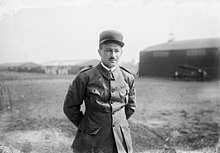 Captain Georges Thenault, French Aviation Service, at Langley Field, Virginia, 4 October 1922 | |
| Born | 15 December 1887 Celle-Lévescault, France |
| Died | 19 December 1948 (aged 61) Paris, France |
| Buried | Crypt of the Lafayette Escadrille Memorial in the park of Ville-neuve L'etang, between the suburbs of Garches and Marne la Coquette |
| Allegiance | France |
| Service/ | French Aviation Service |
| Years of service | August 1914-1937 |
| Rank | Lieutenant Colonel |
| Unit | Escadrille C.11; Escadrille C.34; |
| Commands held | Escadrille C.42, détachement de l'armée de Lorraine (D.A.L.), as commanding officer; Lafayette Escadrille N.124, as commanding officer |
| Awards | Légion d'honneur, Croix de guerre, with four Palms |
Early life
Born on 2 October 1887[2], in the small town of Celle-Lévescault, France (located on main highway between La Rochelle and Tours).[3]
World War I
Standing 5-ft, 8-in, he was a giant in the eyes of his fellow Frenchmen and a respected leader amongst the American volunteer pilots. Identified as N.124, the Lafayette Escadrille was assigned to Groupe de Combat 13 under the overall command of Commandant Philippe Féquant.[4] During 1916-1917, this Groupe de Combat 13 took part in such engagements as the Battle of the Somme, the Second Battle of the Aisne, the Battle of Verdun, and in the Battle of Passchendaele. In early 1918, it operated in the region between Soissons and Reims.
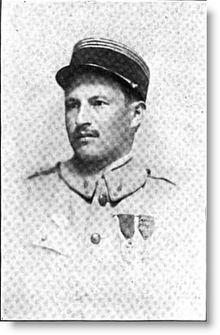
Captain Georges Thenault credits Adjudant Norman Prince for conceiving in November 1914 the idea of bringing together his countrymen with some of those of the French Foreign Legion in a squadron of flyers.[5] Support soon came about from civilian and military representatives of France and the United States. These representatives added expertise and government networking resolving over time the method of recruiting and financing, and successfully encountering the French officialdom. Five influential men instrumental in providing this organizational support included:
- (1) French Foreign Affairs Ministry Official Messr. Maximilien Jarousse de Sillac (31 October 1873, Bordeaux, Gironde department of southwestern France - 1934, Paris, France): career diplomat and conservative French supporter for world peace; assigned as the French Preparatory Commission secretary for the Third Hague Conference that never took place due to the World War [lower-alpha 2]
- (2) Dr. Edmund L. Gros, M.D. (1869-1942), M.D. (11 September 1869, San Francisco CA - 16 October 1942, suburban West Chester, Philadelphia PA): Chief Surgeon & Director of the American Ambulance Corps headquartered in the American hospital at Neuilly-sur-Seine, western suburb of Paris, France; resident of 23 Ave. du Bois de Boulogne, Paris, France (5 January 1911 - September 1940).[6]
- (3) Mr. Frederick Hobbs Allen (30 May 1858, Honolulu, Territory of Hawaii - 4 December 1937, Newport, Rhode Island): Harvard graduate, 1883 with LLB. and AM.; established law firm Allen & Cammann (1900); member of the American Legion and Sons of the American Revolution; residing in Paris when war erupted and became a member of a committee to assist the American embassy in the emergency, and was a chairman of a subcommittee appointed to repatriate American citizens when his advise was requested. He provided U.S. legal guidance that avoided international technicalities confronting American citizens desiring to fight in a foreign war prior to U.S. entry in April 1917.[7]
- (4) Colonel Thomas Bentley Mott, USA, Artillery Corps, American Expeditionary Force (16 May 1865, Leesburg, Loudoun County, Virginia - 17 December 1952, coastal city of Biarritz, Pyrénées-Atlantiques department in the Aquitaine region of southwestern France): graduate of USMA, 1886; served as the senior U.S. Army military attache to the American embassy in Paris, France, 1914 - 1921. His support came from being a U.S. Army liaison officer for General John J. Pershing on the staff of Marshal Ferdinand Foch.
- (5) Brigadier General Victor Paul Bouttieaux, French Army (17 October 1858, Le Quesnoy, Nord, Nord-Pais-de-Calais, France - 22 July 1918, Boursonne, Oise, Picardy, France): A recipient of the highest honor bestowed by France- Officer of the Legion of Honour (1913), he was influential within the French Army staff as Aviation Chief of the French 1st Army (commanded by General Auguste Dubail), reporting directly to the Chief of Staff- General Marie-Georges Demange concerning balloons, airships, and aircraft. In this capacity he commanded six aviation squadrons (1914 - 1918).[lower-alpha 3]
This team of five experts identified the many issues involved and the obstacles that had to be overcome, and helped the first American volunteers to develop a plan:
"There were Americans fighting in the Foreign Legion, but their identity was lost in this body; they were simply units in a tremendous group. Dr. Gros and his associates dreamed of some other form of service in which Americans might participate as Americans, even though the flag of the United States might not officially be carried into the war. The idea was constantly before them, and, when they found that among the Americans already in France and already anxious to help as best they might, were men who had learned the art of flying in this country, the plan for a special American flying corps was conceived and developed."[8]
Final approval for this plan was given by Major General Auguste Edouard Hirschauer (16 June 1857, Saint-Avold, Moselle, Lorraine region of France - 27 December 1943, Versailles, Yvelines, region Ile-de-France)- Chief of French Military Aeronautics for the Ministry of War (1914 - 1915).[9]
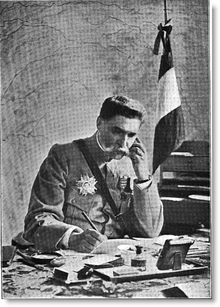
It started with a group of American volunteers (Norman Prince, William Thaw,[lower-alpha 4] Victor Chapman, Kiffin Rockwell, James McConnell, Clyde Balsley, Chouteau Johnson, Lawrence Rumsey, Paul Rockwell) in Paris, France, where they met to discuss how would one be able to enter the French Aviation Service to fly combat missions against the Germans. They met Monday evening, 17 April 1916, at a Paris restaurant to celebrate the final and definite organization of the Escadrille Americaine.[10]
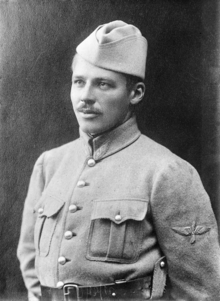
They became the first group to enter the French Aviation Service under the guidance of a distinguished French pilot, Captain Georges Thenault. The Escadrille N.124, first called the Escadrille Americaine, then the Escadrille des Volontaires, and finally the Escadrille Lafayette, was formed on Wednesday, 15 March 1916, under the command of Captain Georges Thenault. Into this squadron came more American volunteers who were at one time automobile mechanics, ambulance drivers, and members of the French Foreign Legion.[11] They became an elite corps of volunteers administratively assigned to this squadron. Thus, began the association called the Franco-American Flying Corps- later to be known as the Lafayette Flying Corps.
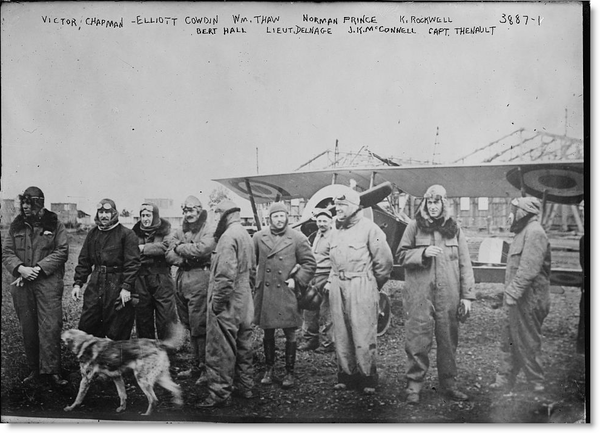
The Lafayette Escadrille was from the beginning a chasse, or pursuit, squadron. Originally provided with the thirteen (square)-meter Nieuport 11, armed with a single Lewis gun on the top plane, it changed successively to the Vickers-armed fifteen (square)-meter Nieuport 17, SPAD S.VII with a single Vickers machinegun, and the SPAD S.XIII with the twin-Vickers machinegun.
Between 20 October 1917 to early February 1918, the process of releasing the American volunteers from the Lafayette Escadrille so that they could become commissioned pilots of the United States Army Air Service was slow.[12] This was mainly due to the required bureaucratic civil and military endorsements that took place between the French Bureau of the Minister of War and to the American Expeditionary Force, Chief of Staff Major General James William McAndrew, U.S.A.[13]
On Monday, 18 February 1918, under the provisions of a curious and interesting agreement between the French and American armies, the Lafayette Escadrille became the 103d Aero Squadron – originally known as 103d Pursuit Squadron – United States Army Air Service. During its tenure, the Lafayette Escadrille had officially confirmed by the military authorities, 199 German aircraft. Of these volunteer pilots, five died of illness; six by accidents in the aviation schools; fifteen were taken prisoners; nineteen were wounded in combat; and, fifty-one were killed over the front lines. The French government recognized the American volunteers for their heroic achievements in the skies over France with the following: four Legions of Honor, seven Medailles Militaires, and thirty-one citations (each with a Croix de guerre).
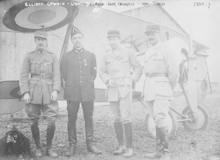
After the disbandment of the LaFayettee Escadrille, Captain Thenault accepted orders as chief pilot at the French School of Aerial Acrobacy & Combat at Pau, Pyrénées-Atlantiques, remaining there for the duration of the war.
Interwar years
Following the end of World War I, Captain Thenault continued military service in the Armée de l'Air (ALA)- literally Air Army, and found time to compile his personal diary notes into a historical work pertaining to the famous LaFayette Escadrille published in Boston MA by the Small, Maynard & Company, Inc. Captain Thenault wrote his book at his home located in Vaux-en-Couhe Vienne France (Vaux, Vienne). Between 1919 and 1921, Thenault purposely wrote this book to place on record the exploits and sacrifices of those daring American volunteers who served under his command and who gave so noble a response to the "deed of LaFayette" whom they chose as their namesake.[14]
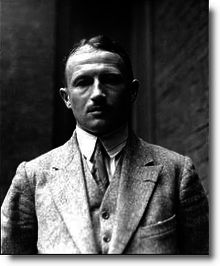
Captain Thenault's book gained widespread American public recognition. In May 1922, he accepted an assignment that began an eleven-year diplomatic service in the Embassy of France in Washington, D.C.. This started with the position of Assistant Military Attache for Aeronautics and later evolved into the position of Military Attache for Aeronautics at the French Embassy in Washington DC (1922–1933). Thenault's travel to the United States began under a French diplomatic passport to the French embassy in Washington DC aboard SS France (1910) departing from Port of Le Havre, Saturday, 15 July 1922, and arriving Port of New York, Saturday, 22 July 1922.[15]
Late fall 1922 plans were announced of Captain Georges Thenault to wed Mlle. Paule Dumont in Washington DC – daughter of the French embassy's Military Attache for Aeronautics Colonel George A. L. Dumont, French Air Army.[16] The wedding was to have taken place in the fall of 1922.
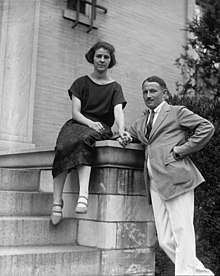
Then in the fall of 1925, the engagement of Ms. Sarah Spencer to Commandant Georges Thenault was announced in Washington DC society circles.[17] She was the daughter of Oliver Martin Spencer of Chicago (general solicitor of the Chicago, Burlington and Quincy Railroad)[18] and of Mrs. Katherine (Turner) "Danny" Spencer,[19] and a grandniece of the Honorable William J. Stone of Ripley County, Missouri.[20] This engagement was released by The New York Times as follows:
"MISS SPENCER TO WED COMMANDANT GEORGES THENAULT. Chicago Girl Is Engaged to Former Commander of the Lafayette Escadrille. Mrs. Oliver M. Spencer of Chicago and St. Joseph, Mo., has announced the engagement of her daughter, Miss Sarah Spencer, to Commandant Georges Thenault, Assistant Military Attache for Aeronautics of the French Embassy in Washington. mis Spencer attended Miss Hall's school at Pittsfield, Mass., and is a member of the Chicago Junior League. She is a daughter of the late Justice Spencer of the Chicago, Burlington and Quincy Railroad, and a grandniece of the late Senator William Joel Stone of Missouri. Major Thenault was commander of the Lafayette Escadrille from the time of its formation in April, 1916, until it disbanded in January, 1918. he published a book entitled 'The Story of the Lafayette Escadrille'. His appointment as attache to the United States in 1922 was intended as a compliment to America and especially as a mark of appreciation for the services rendered by American members of the escadrille."
A number of U.S. Army Air Service and French Aviation Service aviators who won their spurs during the World War periodically made visits to the French embassy, attending conferences, luncheons and dinner engagements in Washington DC. One of the well-known visitors at the time was Captain René Fonck, French Aviation Service.[21] He arrived in the United States at the Port of New York aboard the steamship RMS Olympic, on Tuesday, 6 October 1925.[22] Captain Fonck was in Washington DC for two reasons: (1) upon the invitation from the defense attorney for Colonel Billy Mitchell, U.S. Army Air Service; and, (2) to attend the international air race at Mitchell Field, Long Island, for the Schneider Trophy.[23] Colonel Mitchell invited Captain Fonck on his behalf to reveal the truth about French aviation against the Riffs, and to testify the French Aviation Service had broken down against the Riffs because the fliers were placed under the command of infantry and artillery officers who had no flying experience.[24]
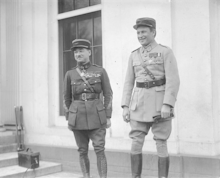
Promoted to commandant in 1923, Thenault completed his six-year tour as military attache in spring 1928, went to France and later returned to the United States reporting to the French embassy in Washington DC, Friday, 27 July 1928, as Military Attache for Aeronautics- replacing newly promoted Brigadier General Georges Armand Louis Dumont. In this assignment Commandant Thenault sought to strengthen bonds of friendship between the United States and France by traveling through a number of cities visiting aircraft factories, conferring with aeronautical experts, and inspecting Army air stations in order to keep his government informed of American progress in the aircraft industry.
Promoted to lieutenant colonel in 1933 following successful completion of duties as military attache for aeronautics at the French embassy in Washington DC, he returned to France and continued his military services with the French Air Army.
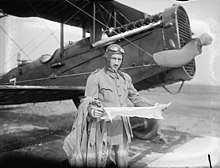
World War II
Lieutenant Colonel Thenault with his family (wife Sarah, children Catherine and Georges) were residing in France when World War II erupted. Their residence was 56 Rue Tahère Saint-Cloud- western suburb of Paris. Prior to the armistice and the cease-fire that went into effect on Tuesday, 25 June 1940, Georges Thenault had plans in place to remove his American wife, the two children, and mother-in-law Katherine "Danny" Spencer out of Europe. In mid-July 1940, using their U.S. passports as identification, Danny and Sarah with the two children were able to travel through Spain via train to reach the Port of Lisbon, Portugal, where they boarded SS Exochorda on Thursday, 25 July.[25] Crossing at high speed over the steamship was able to successfully transit through the U-boat infested waters of the North Atlantic, to arrive at the Port of New York, Friday, 2 August 1940. With Katherine, Sarah and the two children eventually arrived at Harwich Port, Massachusetts, where they resided in the home of her mother during remainder of World War II.[26]
During World War II, Thenault resided in the Occupied Zone of France (Military Administration in Belgium and North France) involved with personal business while his wife Sarah resided at Harwich Port, Massachusetts, with their two children: Georges Spencer and Catherine Bathilde.
Final years
While on a hunting trip outside Paris, Thenault suffered a heart attack. He died in Paris, France, on Sunday, 19 December 1948. He was buried on Thursday, 30 December 1948, with all military rites in the presence of many French and American representatives in the crypt of the LaFayette Escadrille Memorial Monument in the park of Villeneuve L'etang, between the suburbs of Garches and Marnes-la-Coquette.[27] Details of the burial services are obtained from a special article from The New York Times:
"COL. THENAULT IS BURIED. Rites for French Air Hero Held at Lafayette Escadrille Park. Special to The New York Times. PARIS, Dec. 30- In the presence of many French and American aviation enthusiasts including fliers of both World Wars, Col. Georges Thenault, French pilot who commanded the Lafayette Escadrille in the first World War, was buried with military rites today. The burial was in the crypt of the Lafayette Escadrille Memorial in the park of Ville-neuve L'etang, between the suburbs of Garches and Marne la Coquette. The memorial, endowed by the generosity of the late William Nelson Cromwell, serves also as the tomb for pilots who were with the squadron and as a monument on which has been inscribed the names of all the American volunteers. Present at the ceremonies today were Jean Moreau, Secretary of State for Air; Col. Francis Valentine, air attache of the American Embassy; Vice Marshal Robert Allingham George, air attache of the British Embassy; representatives of the American Aero Club of France and delegates of veterans' organizations."[28]
Family
Thenault was the son of Monsieur and Madame Paul Thenault of Coulombiers, Vienne, France. His wife was the former Ms. Sarah Spencer, and from this union two children were raised: Georges "Tom" Spencer Thenault.[29] and Catherine Bathilde Thenault.
According to The New York Times article released from Washington DC in the Saturday edition of 26 March 1955:
"SOLDIER IS FIANCE OF MISS M'ARTHUR. Georges Spencer Thenault and Ex-Student at the Sorbonne Will Be Wed. Special to The New York Times. WASHINGTON, March 26- The engagement of Miss Beatrice Ashmead MacArthur, daughter of Mrs. Littlefield MacArthur of Washington and Lake Worth, Fla., and of Bowman McCalla MacArthur, also of Washington, to Pvt. Georges Spencer Thenault, U.S.A., has been announced by her mother. The prospective bridegroom is the son of Mme. Georges Thenault of Paris and the late Lieutenant Colonel Georges Thenault, one-time air attache at the French Embassy. Miss MacArthur is a grand-daughter of the late Capt. Arthur MacArthur, U.S.N., brother of General of the Army Douglas MacArthur. Their father was the late Lieut. Gen. Arthur MacArthur, U.S.A. The prospective bride is a grand-daughter also of Mrs. MacArthur of Chevy Chase, Md., Mrs. W. L. Littlefield of Lake Worth and the late Captain Littlefield, U.S.N. She is an alumna of the Holton-Arms School here and studied also at the Sorbonne. Miss MacArthur, who was presented to society here several seasons ago, belongs to the Junior League of Washington. Private Thenault, a graduate of Georgia Institute of Technology, is stationed at Edgewater, Md. He is a grandson of the late Judge and Mrs. O. M. Spencer of St. Joseph, Mo., and the late M. and Mme. Paul Thenault of Coulombiers, France."
Of significant importance is the fact that the son of Colonel Georges & Sarah (Spencer) Thenault, PFC Georges Spencer Thenault, USA, married Ms. Beatrice Ashmead MacArthur on Saturday, 14 May 1955, in St. Margaret’s Episcopal Church (Annapolis, Maryland).[30] Details are derived from The New York Times special article released from Washington DC on 14 May 1955:
"MISS M'ARTHUR WED IN CAPITAL. Attired in Satin at Marriage in St. Margaret's Church to Pfc. G. S. Thenault. Special to The New York Times. WASHINGTON, May 14- In St. Margaret's Protestant Episcopal Church here this afternoon, Miss Beatrice Ashmead MacArthur was married to Pfc. Georges Spencer Thenault, U.S.A. The ceremony was performed by the Rev. Malcolm Marshall. The bride is a daughter of Mrs. Littlefield MacArthur of Washington and Lake Worth, Fla., and of Boman McCalla MacArthur of Washington. She is a granddaughter of Mrs. Arthur MacArthur of Chevy Chase, Md., and the late Captain MacArthur, U.S.N., brother of General of the Army Douglas MacArthur, and of Mrs. W. L. Littlefield of Lake Worth and the late Captain Littlefield, U.S.N. Private Thenault is a son of Mme. Georges Thenault of Paris and the late Lieutenant Colonel Thenault, one-time air attache at the French Embassy. His grandparents were the late Judge and Mrs. O. M. Spencer of St. Joseph, Mo., and the late M. and Mme. Paul Thenault of Coulombiers, France. The bride, given in marriage by her uncle, Malcolm MacArthur of New York, wore a gown of ivory satin made with a fitted Empire bodice of Chantilly lace and a bouffant skirt ending in a cathedral train. Her long silk tuile veil was fastened to a bandeau of the same material and heirloom rosepoint lace caught by orange blossoms. She carried a cascade bouquet of white carnations and stephanotis. Mrs. David L. Carpenter, Mrs. Wendell N. Vest and Miss Laura MacArthur, a cousin of the bride, were the attendants. R. Tupper Barrett was best man. The ushers were A. Dawson Teague, Mr. Carpenter, Captain Vest, U.S.M.C., Evan Galbraith and Clarence F. Norment 3d. Mrs. Thenault, an alumna of the Holton-Arms School here studied also at the Sorbonne. She belongs to the Junior League of Washington. Her husband was graduated from Georgia Institute of Technology."[31]
According to the morning edition of The Boston Globe, Tuesday, 12 January 2010, the son of Lieutenant Colonel Georges and Sarah (Spencer) Thenault, Georges "Tom" Spencer Thenault, of Harwich Port and Yarmouth Port died at his home on Saturday, 9 January 2010.[32]
World War I Lafayette Escadrille N.124 Citations
- The Lafayette Escadrille was mentioned in the French Army Orders of 23 August 1917 for its gallantry and spirit of sacrifice. This citation, which was signed by General Philippe Pétain, commander-in-chief of the French armies operating on the French front, stated:
"The squadrilla, composed of American volunteers who have come to fight for France in the pure spirit of sacrifice, has fought incessantly under the command of Captain Georges Thenault, who formed it for an ardent flight against our enemies. In very severe combats it has paid for the price of serious losses, which, far from weakening, have increased its morale. The squadrilla has brought down twenty-eight enemy airplanes. It has aroused the profound admiration of commanders who have had it under their orders, and also of French squadrillas which are fighting beside it and have desired to rival it in valor".[33]
- According to an article published within the Aerial Age Weekly journal, the War Department Director of Military Aeronautics Brigadier General William L. Kenly, U.S.A., announced having received (February 1919) a second list of Honors and Awards conferred upon American Aero Squadrons and flying officers of the American Expeditionary Forces.[34] This listing gives citations of five squadrons, including the Lafayette Escadrille, the 17th and 148th which were the British; the 90th and the 99th Squadrons. The citation of the Lafayette Squadron, formerly the Lafayette Escadrille, was signed by General Petain and read as follows:
"Brilliant unit which has shown itself, during the course of operations in Flanders, worthy of its glorious past. In spite of losses which took away a third of its effectives, in a difficult sector, it has assured a perfect security to our Corps Observation airplanes, a complete service of reconnaissance at both high and low altitude, and the destruction, not only near the front lines but deep in the enemy's territory, of a great number of German airplanes and captive balloons".[35]
- According to an article published within the Aerial Age Weekly journal, the War Department Director of Military Aeronautics Brigadier General William L. Kenly, U.S.A., was advised (February 1919) by cable from General Pershing, that the 103d Aero Squadron, formerly the Lafayette Escadrille, was one of the two organizations of the A.E.F. entitled to wear Fourragers awarded by the French government. This organization was awarded the Fourragers in the colors of the Croix de Guerre, having received two citations of the French Orders of the Army.[36]
World War I service record
- FRENCH AVIATION SERVICE ASSIGNMENTS:[37]
- From the beginning of the war.
- Ecole militaire d'Avord, 12 January to 23 March 1915. Lieutenant Thenault trained in the Nieuport 12.[38]
- AT THE FRONT:
- Escadrille C.11, lieutenant, August to 1 December 1914.[39]
- Escadrille C.34, 25 March 1915. Promoted to captain, May 1915.[40]
- Escadrille C.42, détachement de l'armée de Lorraine (D.A.L.), commanding officer, 31 July 1915.[41]
- Escadrille LaFayette N.124, commanding officer, 9 April 1916 to 18 January 1918.[42]
- Chief pilot, School of Acrobacy & Combat at Pau, 18 January 1918 to Armistice
- Assistant military attache for aeronautics: French embassy, Washington DC (1922–1925)
- Military Attache for Aeronautics: French embassy, Washington DC (1925–1933)
- Final rank: lieutenant colonel
- DECORATIONS:
- Légion d'honneur
- Croix de guerre, with four Palms
- Fourragère in the colors of the Croix de Guerre
- CITATIONS:
- French Order of the Army, 27 August 1914, while serving with the Escadrille C.11
- Legion of Honor, 29 October 1914, while serving with the Escadrille C.11
In popular culture
The character of Georges Thenault was played by the French actor Jean Reno in the 2006 American movie Flyboys.
Notes
- Air force officer ranks
- As a political analyst and supporter for the current French government, Messr. Maximilien Jarousse de Sillac envisioned that there might be great advantages in this creation of an American squadron. In a personal letter to his friend Colonel Bouttieaux (written early February 1915), he stated: "The United States would be proud of the fact that certain of her young men, acting as did Lafayette, had come to fight for France and civilization. The resulting sentiment of enthusiasm could have but one effect: to turn the Americans in the direction of the Allies". Attached to this letter was a memo containing the names of the six Americans (William Thaw, Bert Hall, James Bach, Norman Prince, Frazier Curtis, Elliott C. Cowdin). A short reply by letter from Colonel Bouttieaux (dated: 24 February 1915) provided: "I think that your candidates will be welcomed. They should contract an engagement in the French Army for the duration of the war, and should fly only the aeroplanes customarily used in the French Aviation Service". Thus, history should take note that credit goes to M. Jarousse de Sillac for identifying a name for this "all American squadron"- Lafayette Escadrille. Reference source: Flammer, Philip M. The Vivid Air: The Lafayette Escadrille. Chapter 1: "The Genesis of the Lafayette Escadrille", pp 18-19. University of Georgia Press: Athens, Georgia, 2008.
- Colonel Victor Paul Bouttieaux: prior to the commencement of World War I, he was actively involved with the development and advances in heavier-than-air aeroplane technology and lighter-than-air airships, and was responsible for identifying such technological advancements to the Ministry of War for the French Aviation Service. For example, on 28 December 1910, he visited Chalons Camp (Châlons-en-Champagne) in order to observe and report on the new biplane with hood for military use built by Mr. Henry Farman. When France entered into World War I, Colonel Bouttieaux was a leading military aeronautical subject matter expert for the French Ministry of War. This was the main reason why he was chosen as one of the five key committee members to analyze the requirements of Captain Georges Thenault's idea of a new squadron of flyers comprising his countrymen and of French Foreign Legion volunteers. His knowledge with dirigibles and balloons were developed into his book titled La Navigation Aerienne Par Ballons Dirigeables or Air Navigation by Airships (1909, Paris, France). His accidental death while on active duty came too early in life; a great loss for French aeronautics funding, research, and development.
- He was the only member of the original squadron of volunteers who served with it throughout the entire period of its existence.
References
- "LtCol George Thenault (1887 - 1948) - Find A Grave". Findagrave.com. Retrieved 31 July 2015.
- Catalog of the French National Library
- Date of birth and place of birth were derived from the ship's manifest listing. List or Manifest of Alien Passengers for the United States Immigration Officer Port of Arrival: S.S. France, Passengers Sailing from Havre, 15 July 1922. Arrival at Port of New York, 22 July 1922. Passenger and Crew Lists of Vessels Arriving at New York, New York, 1897-1957; National Archives Microfilm Publication Serial T715; Microfilm roll: T715_3146. p 3, no. 27, and p 4, no. 27.
- The Lima News. "Air Pioneer Dies". 25 December 1938. p 2, column 7. "Air Pioneer Dies. Paris, Dec. 24- (UP) - Gen. Philippe Fequant, 55, former chief of staff of the air force and a pioneer in French aviation, died today of heart disease".
- Thenault, Georges (1921). The Story of the LaFayette Escadrille, Told by its commander Captain George Thenault. Boston: Small, Maynard & Company. pp. Introduction xiii.
- "Dr Edmund Louis Gros (11 September 1869 – 16 October 1942) - Find A Grave". Findagrave.com. Retrieved 31 July 2015.
- "Frederick H. Allen (30 May 1858 – 3 December 1937) - Find A Grave". Findagrave.com. Retrieved 31 July 2015.
- The American Review of Reviews: An International Magazine. Editor: Albert Shaw. Vol LVI. July–December 1917. The Review of Reviews Company: New York. "Leading Articles of the Month. The Lafayette Flying Corps". p 192.
- Congressional Medal of Honor, The Distinguished Service Cross, and The Distinguished Service Medal Issued By the War Department Since April 6, 1917, Up to and Including General Orders, No. 126, War Department, November 11, 1919. Compiled in the Office of the Adjutant General of the Army. "Distinguished Service Medal: Auguste Edouard Hirschauer". p 910. Government Printing Office: Washington 1920. The U.S. War Department awarded Major General Hirschauer, French Army, commanding the 2d Army, with the Distinguished Service Medal. "For exceptionally meritorious and distinguished services rendered to the American Expeditionary Forces and to the cause in which the United States has been engaged". Major General Hirschauer's aviation influence derived from his experience and work in these areas: (1) commander of the 25th Engineer Battalion comprising four airships (1904 - 1906), (2) professorship of military engineering and aviation at the Graduate School of Marine War (1907 - 1912) where his influence helped change the terminology designating heavier-than-air aerostat to plane (officially accepted on 29 November 1911), (3) as permanent chief inspector of military aviation (1912), (4) at the outbreak of war commanded a brigade of balloonists with the 5th and 8th engineering regiments of Versailles (1914 - 1915), and thus became recognized by the French military staff as one of the founding fathers of French Aviation Service- Service Aéronautique. Also, in receipt of the DSM were: Messr. Maximilien Jarousse de Sillac, Dr. Edmund Louis Gros , Mr. Frederick Hobbs Allen (30 May 1862, Honolulu, Hawaiian Territory - died), Colonel Thomas Bentley Mott, USA, AEF, USMA-Class of 1886, whose book provided some details in assisting the aviation efforts Twenty Years As Military Attache (Oxford University Press: New York, 1937), and Colonel Paul Bouttieaux, who eventually reached the rank of brigadier general before being killed in an automobile accident. Served in the French Aviation Service for thirty years, and made the first experiments with aerial telephotography. Prior to his death held the position of French commanding officer of engineers.
- Nordhoff, Charles Bernard. The Lafayette Flying Corps In Two Volumes, Volume I. Edited by James Norman Hall. "The Escadrille Lafayette At the Front". Chapter II, p 17. Houghton Mifflin Company: Boston MA 1920.
- After the beginning of the American Ambulance Hospital in Paris, early in the winter of 1914, more and more automobiles were given by Americans, and these cars and their drivers- usually American volunteers- became the nucleus of the Paris branch of the American Ambulance Service. Also, AFS Intercultural Programs
- On Monday, 1 October 1917, in compliance with Special Order No. 113, para 3, Headquarters A.E.F., a special Board comprising four A.E.F. officers was ordered to convene at the Aviation Headquarters, Paris, to examine American citizens in the French Aviation Service; purpose: to examine certain American citizens, now commissioned or enlisted in the French Aviation Service, who desired to obtain their release for the purpose of entering the Service of the United States. The Board recommendations were submitted on Saturday, 20 October 1917, to the French authorities (documents were translated to French) for their endorsements.
- http://www.arlingtoncemetery.net/jmcandr.htm
- Thenault, Georges. The Story of the LaFayette Escadrille- Told By its Commander Captain Georges Thenault (Translated by Walter Duranty, with An Introduction By Andre Tardieu- High Commissioner of Franco-American Affairs). Boston: Small, Maynard & Company, 1921.
- List or Manifest of Alien Passengers for the United States Immigration Officer Port of Arrival: S.S. France, Passengers Sailing from Havre, 15 July 1922. Arrival at Port of New York, 22 July 1922. Passenger and Crew Lists of Vessels Arriving at New York, New York, 1897-1957; National Archives Microfilm Publication Serial T715; Microfilm roll: T715_3146. p 3, no. 27, and p 4, no. 27.
- Iowa City Press-Citizen. "Flyer to Wed". Wednesday, 4 October 1922, front page, column 7.
- "Sarah Spencer Thenault (25 July 1900 - May 1979) - Find A Grave". Findagrave.com. Retrieved 31 July 2015.; last residence: Harwich Port, Barnstable County, Massachusetts 02646.
- "Judge Oliver Martin Spencer (23 August 1849 – 5 June 1924) - Find A Grave". Findagrave.com. Retrieved 31 July 2015..
- "Katherine E. Turner Spencer (6 February 1874 – 20 November 1941) - Find A Grave". Findagrave.com. Retrieved 31 July 2015..
- The New York Times. "Four Brides Have Autumn Weddings. Chicago Girl Is Engaged to Former Commander of the Lafayette Escadrille". Fall 1925. Also, "William Joel Stone (7 May 1848 – 14 April 1918) - Find A Grave". Findagrave.com. Retrieved 31 July 2015..
- "Col Rene Paul Fonck (27 March 1894 – 18 June 1953) - Find A Grave". Findagrave.com. Retrieved 31 July 2015..
- Form 500. U.S. Department of Labor. Immigration Services. List Or Manifest Of Alien Passengers For The United States Immigration Officer At Port Of Arrival. List No. 6, p 21. S.S. Olympic, Passengers Sailing From Cherbourg, 30 September 1925. Arriving at Port of New York, 6 October 1925.
- Upon the conclusion of World War I, upon Lieutenant Rene Fonck, French Aviation Service, had fallen the palms of supreme victory in the air. This much decorated young officer was awarded the Croix de Guerrre with 19 palms, the Medaille Militaire, the order of the Belgian Crowns, the Order of Leopold, the British Distinguished Service Medal, and was an officer of the Legion of Honor. His victories in the air: 75 official and 40 unofficial victories to his credit. He survived four years of intense warfare without receiving so much as a scratch, winning for him the title "Ace of All Aces", allied and enemy.
- The Chronicle Telegram. "Mitchell Calls Foreign Airmen. Court Martial Takes On International Flavor With Defense Planning Support of Charges With Testimony From British and French Aviators". Thursday, 5 November 1925. p 9, column 1.
- SS Exochorda was operated by the American Export-Isbrandtsen Lines.
- Form 630. U.S. Department of Labor. Immigration and Naturalization Service. List of United States Citizens (For the Immigration Authorities). no. 2, p 91, list no. 27-30. S.S. EXOCHORDA, Sailing from Lisbon, Portugal, 25 July 1940, Arriving at Port Of New York, 2 August 1940. Names: Katherine Spencer, Sarah Thenault, Georges Thenault, Catherine Thenault (27-30, respectively). Address in the United States: Harwich Port, Massachusetts
- The New York Times. "Col. Thenault Is Buried. Rites for French Air Hero Held at Lafayette Escadrille Park". Special to The New York Times. Paris, 30 Dec. [1948].
- Robert George (RAF officer): Air Vice Marshal Sir Robert Allingham George. Also, Aero Club of America.
- "Georges Spencer Thenault (28 May 1930 – 9 January 2010) - Find A Grave". Findagrave.com. Retrieved 31 July 2015.
- Georges Spencer Thenault: born (City of Washington, District of Columbia, 28 May 1938); sister Catherine Bathilde Thenault: born (Hyannis, Massachusetts, 22 July 1928).
- The New York Times. "Miss M'Arthur Wed In Capital. Attired in Satin at Marriage in St. Margaret's Church to PFC G. S. Thenault". Special to The New York Times. Washington, May 14.
- The Boston Globe. Obituaries. Georges Spencer Thenault. Tuesday, 12 January 2010.
- Air Service Journal. 30 August 1917. "Aerial Operations on the War Fronts. Western Front. Lafayette Squadron Mentioned in French Army Orders". vol. 1, no. 8, p 248.
- Director of Military Aeronautics: position is selected and designated by the Commander in Chief of the Army. Under direction of the Secretary of War, the Director of Military Aeronautics was given charge of the Aviation Section of the Signal Corps of the Army; with duties of operating and maintaining or supervising the operation and maintenance of all military aircraft, including balloons and aeroplanes, all appliances pertaining to said aircraft and signalling apparatus of any kind when installed on said aircraft, and of training officers, enlisted men, and candidates for aviation service in matters pertaining to military aviation. Reference source: Aerial Age Weekly. "Report of the Director of Military Aeronautics- War Department, Office of the Director of Military Aeronautics (03 November 1918)". vol 8, no. 14. 9 December 1918. pp 720-722.
- Aerial Age Weekly. "Naval and Military Aeronautics. Air Service Citations Number Three Hundred Seventy-Four". vol 8, no. 24. 24 February 1919, p 1175.
- Aerial Age Weekly. "Naval and Military Aeronautics. Fourragers". vol 8, no. 25. 3 March 1919, p 1266. Fourragère
- Nordhoff, Charles Bernard. The Lafayette Flying Corps- In Two Volumes, Volume I. Edited by James Norman Hall. "Captain Georges Thenault". p 78. Houghton Mifflin Company: Boston MA 1920. Volumes I and II are a rich reference source of details and illustrations, including a well written story of the origin of the Escadrille Americaine and biographical sketches of the Corps and their friends. The author has drawn from earlier articles and books such as James R. McConnell's Flying for France (autumn 1916); Charles J. Biddle's The Way of the Eagle (1919); and from Ruth Dunbar's story Severely Wounded (originally printed in the Century Magazine, February 1919 edition).
- http://albindenis.free.fr/Site_escadrille/Ecoles_Avord.htm
- Squadron insignia: the cocotte- a stylized bird made from folded paper; squadron aircraft LT Thenault flew: Caudron G.3
- Squadron insignia: fox; squadron aircraft Captain Thenault flew: Caudron G.3
- Squadron insignia: Lion Cub; squadron aircraft Captain Thenault flew: Caudron G.4; Nancy, Luneville
- Squadron insignia: native American Indian with full war bonnet; squadron aircraft Captain Thenault flew: Nieuport and Spad. By the middle of the summer of 1917, the squadron was complete with Spads
Bibliography
- Nordhoff, Charles Bernard. The Lafayette Flying Corps In Two Volumes, Volume I. Editor: James Norman Hall. "The Escadrille Lafayette At the Front". Chapter II, p 17. Houghton Mifflin Company: Boston MA 1920.
- Nordhoff, Charles Bernard. The Lafayette Flying Corps- In Two Volumes, Volume I. Edited by James Norman Hall. "Captain Georges Thenault". p 78. Houghton Mifflin Company: Boston MA 1920. Volumes I and II are a rich reference source of details and illustrations, including a well written story of the origin of the Escadrille Americaine and biographical sketches of the Corps and their friends. The author has drawn from earlier articles and books such as James R. McConnell's Flying for France (autumn 1916); Charles J. Biddle's The Way of the Eagle (1919); and from Ruth Dunbar's story Severely Wounded (originally printed in the Century Magazine, February 1919 edition).
- Shaw, Albert. Editor. The American Review of Reviews: An International Magazine. Vol LVI. July–December 1917. The Review of Reviews Company: New York. "Leading Articles of the Month. The Lafayette Flying Corps". p 192.
- Thenault, Georges. The Story of the LaFayette Escadrille- Told By its Commander Captain Georges Thenault (Translated by Walter Duranty, with An Introduction By Andre Tardieu- High Commissioner of Franco-American Affairs). Boston: Small, Maynard & Company, 1921.
External links
| Wikimedia Commons has media related to Georges Thenault. |
- Der rote Baron (2008)
- Flyboys (2006)
- House Report 107-333 - National Defense Authorization Act for Fiscal Year 2002 CONFERENCE REPORT
- Expressing the sense of Congress that the United States should continue to honor its commitment to the United States aviators who lost their lives flying for France during World War. Introduced in House- 13 June 2001
- Restoring the Lafayette-Escadrille Memorial -- (House of Representatives - 1 May 2001)
- Von Richthofen and Brown (1971)
- Darling Lili (1970)
- The Blue Max (1966)
- Lafayette Escadrille (1958)
- The Tarnished Angels (1958)
- The Dawn Patrol (1938)
- Hell's Angels (1930)
- Wings (1927)
- Major General James William McAndrew, USA
- Ecole militaire de pilotage d'Avord
- Lafayette Escadrille Memorial and Burial Crypt, Parc de Villeneuve-l'Etang Garches, France
- The Early Birds of Aviation, Inc. Copyright@ 14 January 2000, Ralph Cooper; revised: 13 October 2009. Photos of Captain Georges Thenault
- The American Friends of Lafayette. A Message from the President of The American Friends of Lafayette. Robert Rhodes Crout, President. 77th ANNUAL MEETING OF THE AMERICAN FRIENDS OF LAFAYETTE NEWPORT, RHODE ISLAND – JUNE 11-13, 2009
- The Lafayette Escadrille: Their Role in the Great War 1916 - 1918. © 2005-2006 The New England Air Museum
- American Ambulance Hospital of Paris- The Field Service
- A Multimedia History of World War One: Prose & Poetry- Literary Ambulance Drivers
- History of the American Field Service in France: Friends of France, 1914-1917, Told By Its Members With Illustrations. Houghton Mifflin Company: Boston and New York: 1920
- World War I: Aircraft of France